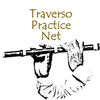|
Enrico Coden is an Italian flute player, researcher, and teacher based in Haarlem (The Netherlands).
He performs music from the Renaissance to the present day through the lenses of historically informed performance practice. He plays with several renowned ensembles, such as Balthasar Neumann Ensemble, Il Gusto Barocco and Orchestra Frau Musika. As a researcher, he focuses on Italian flute methods between the 18th and 19th centuries. https://enricocoden.com |
|
The first thing you do when you pick up your traverso to start the practice day, and why?
|
After having put the traverso joints together, the first step I take is to improvise (or, to be more historical, to prelude) for a few minutes, simply following where the fingers, the lips and the airflow bring me. This “letting it happen” allows me to scan my body and to have a clearer picture of what is working as I would like to and what is not. Not all days are the same: I might be able to easily produce a nice tone without warming up, but it might also happen that I make the traverso sound like a beer bottle; or that my fingers are immediately reactive, or that they seem to be made of wood.
|
|
Any recurring piece to play every day, and why?
|
Since all days are different, I do not have any recurring pieces that I play every day.
|
|
Do you have a daily routine?
|
For the same reason, I do not have a general and systematic daily routine.
|
|
What kind of goals do you set for your practice?
|
After having spotted what I would like to focus on that day, I work on one or more specific aspects through some exercises that I learned during my studies with Claire Genewein and Kate Clark. For example, if I feel that the full resonance of my body is not there, I play long notes with an extreme messa di voce, starting pianissimo and trying to reach the maximum volume allowed by the note. Or, if I am not satisfied with the way that I am connecting the notes, I practice chromatic scales from the low to the middle D and then play a singing exercise adapted by Claire Genewein after Porpora. This same exercise, when transposed chromatically in all tonalities (yes, even D-flat major), is my secret weapon for waking up lazy fingers. Lately, I have also been enjoying improving my finger technique through the possible reconstruction of some 18th-century oral exercises made by João Carlos Ferreira de Miranda Santos.
|
|
Do you do any systematic warm-up?
|
I make my warm-up systematic in relation to my needs of the day by working towards specific goals.
|
|
Do you have a specific structure for warm-up and practice sessions?
|
Only when I feel that I can play with enough flexibility and ease (or when I peacefully accept that a day is just not an excellent one - it does happen!), I move on to the repertoire.
|
|
Any distinctive characteristics of baroque flute daily practice vs. modern flute or other instruments?
|
In my experience, practising on the baroque flute means playing in a more complex and flexible way than on the Boehm flute: the instrument is more sensitive and the music requires more finesse, more variety and more details.
For example, I never practised long notes with messa di voce on the Boehm flute, where I look perhaps for a general and equal fullness of tone throughout all registers; but extreme dynamic flexibility is something I feel I absolutely need to master on the baroque flute to be able to express all the nuances that I believe the music needs, such as the difference between good and bad notes. The same applies to articulation: while on the Boehm flute I am happy if I have an - again! - equal double-tonguing, on the baroque flute I try to make as clear as possible the difference between all possible articulation syllables (tu, ru, did’ll). |
|
What are the key elements and unmissable points of daily practice?
|
For me, they are aiming at playing with ease and reaching a tiny but significant improvement every day - whatever is important on that day!
|
|
How long and distributed should warm-up and practice be?
|
As you probably understood by now, I do not have a fixed standard concerning warm-up and practice timing. On the contrary, I believe that it can be different from day to day: sometimes I just play some improvised preludes for 2 minutes and I am good to go, while other days I might only play technical exercises to feel more at ease with the instrument.
|
|
Any specific tip to address difficult technical passages during daily practice?
|
What I try to do is to understand where the difficulty lies. Usually, there is a connection between two notes of a passage that makes it difficult. This connection often involves one weird movement for a finger, or a synchronization problem between two fingers. My strategy, then, is to play the passage slowly, understand which fingers create the issue and practice their movement separately. When I feel I can play it with ease, I add the rest of the fingers (always paying attention to avoid any tension). Only then, I gradually increase the speed.
|
|
Are there any tools that are particularly useful for practicing?
|
Lately, I have been trying to avoid practising with modern tools, such as the metronome. (There is a very interesting quote by Diderot saying that musicians of his time hated mechanical tools to keep the tempo because they did not allow them to play freely!) I admit that it can be useful for practising scales and arpeggios, but I also believe that the risk is to start thinking in a too “literal” way and less in gestures. I rather try to understand what is the issue that prevents me from playing freely and working in a more “surgical” way by fixing a certain connection.
The same applies to tuning. While it can be useful to know more or less which notes are sharp and flat by using a tuner, the risk of playing with the eyes and not with the ears is always very high. Therefore, I try to practice intonation on a pedal note (which can be produced by a tuner, of course!) to develop my inner ear and a feeling for correct intervals, rather than checking now and then if I am too sharp or too flat. |
|
Any other general advice, suggestion, tip?
|
I think it is very important to keep daily practice a pleasing experience to avoid the feeling that it is a dry yet necessary duty. I find it particularly helpful to think in a "pre-revolutionary" way, without separating the technique from the musical content, for example by practicing scales or arpeggios in a certain affect.
|
|
How do you advise your students as far as structuring their daily practice?
|
I try to deliver to my students the idea that technique and, therefore, daily practice is a means and not a goal.
|
|
Do you suggest or teach a warm-up routine?
|
For the above reason, I first try to spot some issues that might be stopping them from fully expressing their imagination, and then either I suggest some exercises from my repertoire or I create tailored exercises for their needs. A tailored set of exercises, based on their needs, would become their warm-up, which I suggest to be always flexible and enjoyable rather than strictly prescriptive and systematic.
|
|
Are there any specific pieces particularly beneficial to be played regularly in daily practice?
|
I am not sure whether there are universal pieces valid for everybody. However, I am very fascinated by the idea of practicing as much as possible as they were. In this sense, I regard Quantz' 'Caprices and Solfeggi' and etudes from late 18th-century methods as very useful tools to get into the mind of traverso students of the time.
I also think they are suitable for every level: while a beginner can become acquainted with new tonalities and fast passages, an advanced player can enjoy differentiating articulation syllables or "good" and "bad" notes. |



